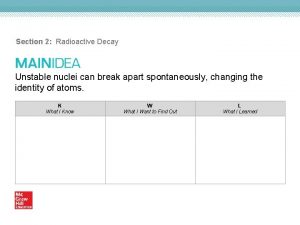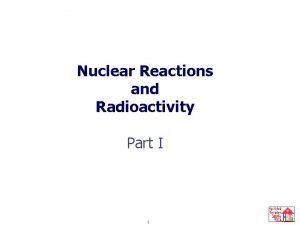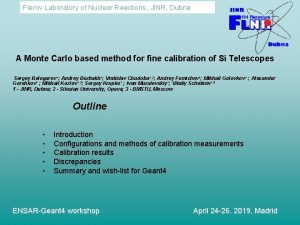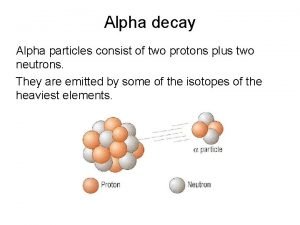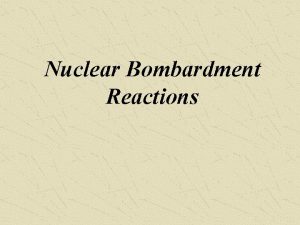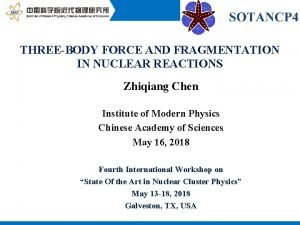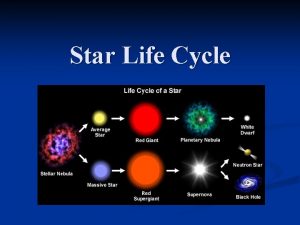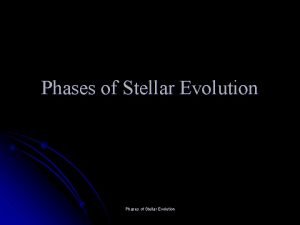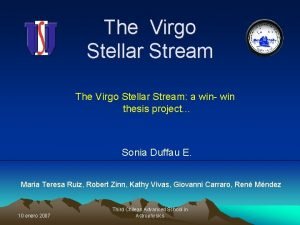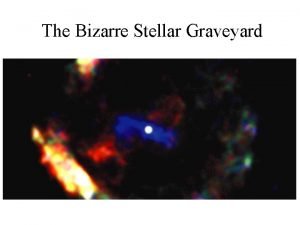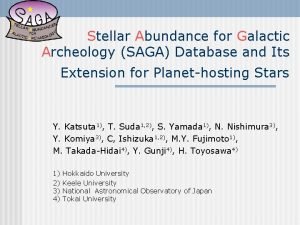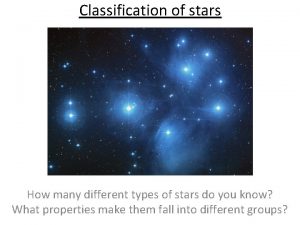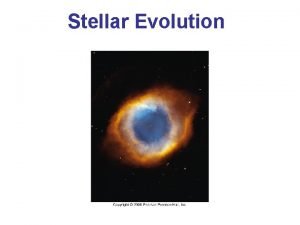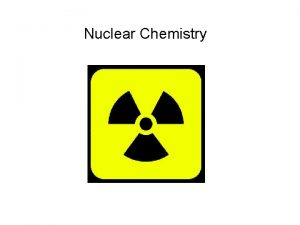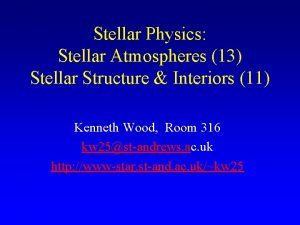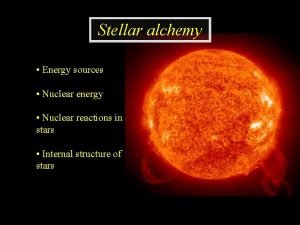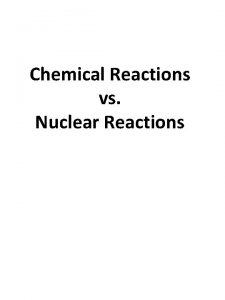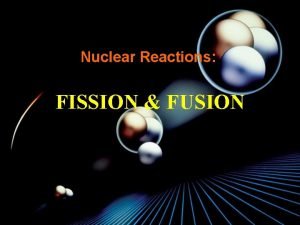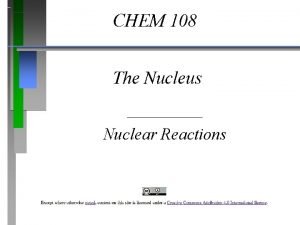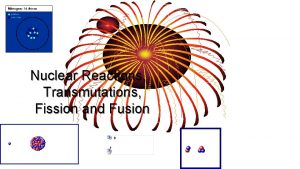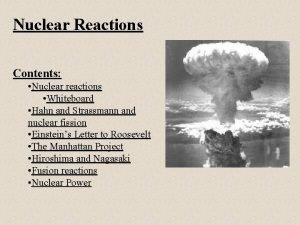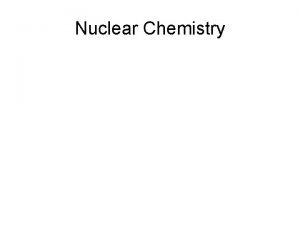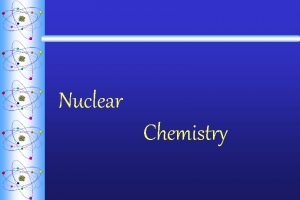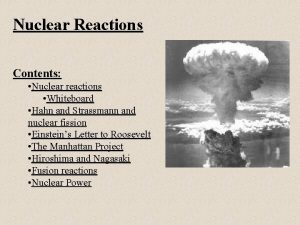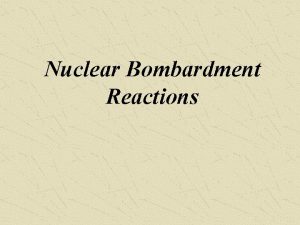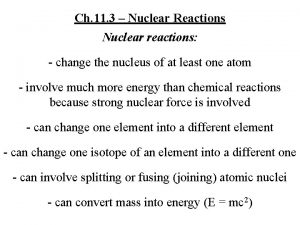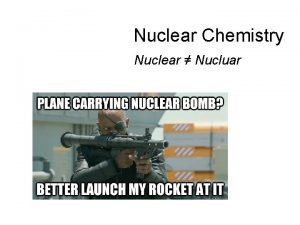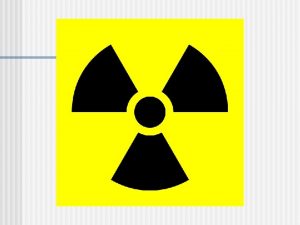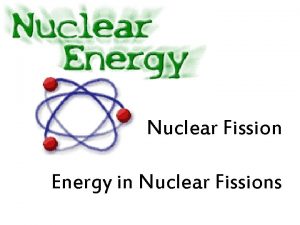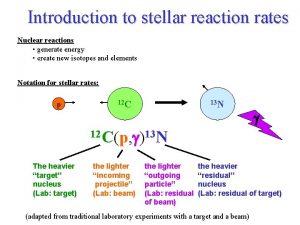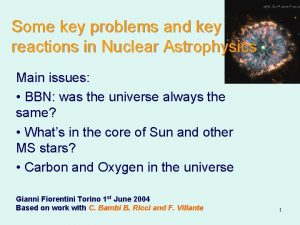Impact of Key Nuclear Reactions on Stellar Structures































- Slides: 31

Impact of Key Nuclear Reactions on Stellar Structures & Nucleosynthesis This is a sea view of the American University of Beirut Mounib El Eid meid@aub. edu. lb Russbach: March 2015

A message My work always tried to unite the true with the beautiful, but when I had to choose between one or the other, I usually chose the beautiful. Hermann Weyl

Outline 1. 2. blue loops of intermediate mass stars –CNO species Massive star- s-process 3. AGB stars –s-process 4. It is a selection about which I know what I am talking about

1. The CNO cycle Energy generation rate mainly controlled by this slowest reaction in the CN cycle: nuclear Neutrino processes near T=25 106 K

Level scheme in 15 O The S-factor used to get the C-rate is derived from Rmatrix fit for the 6. 791 Me. V and ground state transition, the recommended Sfactor for 6. 172 Me. V (Adleberger et al 2011), the LUNA fits for the weaker transition to the 5. 241 Me. V and 5. 181 Me. V states (Imbriani et al 2005). N RE C A / A UN RE C NA L Champagne/NACRE C-rate S-factor Reaction rate

Summary: shows complicated interplay of direct and resonant capture. The resonant capture involves a sub-threshold resonance at -504 Ke. V (Ex=6. 791 Me. V state in 15 O), and a low energy resonance at Ecm=259 Ke. V and interference between the sub-threshold resonance and the higher excitation states Effects on stellar evolution See next ��

How are the loops initiated? N energy generation rate XH 1 T 2 3 It is the enforcement of the H-burning shell which initiate the loop

Effect of the Loops suppressed For M/Msun = 5 -8 Loops recovered, how? Cepheid variables

Recovering the blue loops Through modified mixing Z-=overshoot distance, in terms of pressure scale height Hp The parameter f determines how fast D decreases

6 Msun Loop recovered (dashed line). core overshooting establishes higher T in the H-shell region, while envelope overshooting leads to deeper penetration of the H-profile. Dashed line : overshoot distance od 0. 1 Hp, loop recovered. T does not fall as rapidly as in case without overshooting Solid line: no overshoot, loop suppressed

Overshoot distance from the edge of the core by 0. 5 Hp suppresses the loop, slice the H-shell would operate. Not efficient H-shell burning to initiate the loop during core Heburning for this 6 Msun star

The Energy levels above and near the threshold of 12 C( , ). For temperatures T 9=1. 0 and above, the effective stellar energy is near E 0=0. 30 Me. V (Gamow peak). This energy is reached by the low energy tail of the resonance centered at 2. 42 Me. V (center of mass energy): Two other sub-threshold resonances: 12

Several evaluations of He burning; 15 -30 MSun CF 85: Caughlan et al ; Atom. . Data Nucl. Data Tables, 32, 197 (1985) Kunz: Kunz etal. APJ, 567, 643 (2002) NACRE: Angulo et al , Nucl. Phys. A, 656, 3 A, 1999 Buchmann: 1996, APJ, 468, L 127 (1996) 13

Neutrino Processes Quantized collective charge oscillations in an ionized gas Like Compton scattering , but outgoing photon replaced by neutrinos. Important in carbon burning

Carbon burning

see El Eid, Meyer, The APJ 611, 452 (2004) Dark areas: CONVECTIVE The, El Eid, Meyer: APJ, 655, 1058, (2007) Note that the energy production does not comprise the whole convective core NACRE 16

Imbriani et al (2001), Ap. J 558, 903 25 Msun star Rate of CF 85 X 12=0. 18 CF 85 > CF 88 X 12 lower No convective carbon-burning core No convective core Remaining car bon mass fraction CF 88 X 12=0. 42 But here

Woosley, Heger &Weaver (2002) Rev. Mod. Phys. 74, 1015 No convective carbon-burning core

Central Heburning NACRE rate smaller than that of CF 88 up to T 8=2. 4 14 N( , ) 18 F(e+, ) 18 O ( , ) 22 Ne( , n) 25 Mg This happens at begin of central helium burning. This becomes effective near end of central Heburning 19

25 M_sun

25 M_un

S-process in massive stars (15 Msun and above) : main characteristics, sure about it In core He-burning, s-process rather sensitive to the reaction s-process in Carbon-shell burning depends on the evolution of massive stars during core He-burning and the ensuing carbon burning. In particular, on the location of the carbon shells. This is related to the mass fraction of carbon (X 12) determine by the operating in late phase of core He-burning If X 12 is relatively low, the s-process occurs later during Ne-burning. This leads to higher neutron density in the range of 1011 n/cm-3. Consequently, some production of 90 Zr is possible. If X 12 is relatively high (Kunz et al rate), then the s-process occurs earlier in the evolution (before Ne burning. Consequently, lower neutron density is achieved, and only the Sr-region is reached- that is amazing

AGB Stars and s-process Concerning the s-process In HR Diagram “Cat Eye” planetary nebula after the AGB phase 23

loop 5 M 2 nd Dredge up end core He-burning 1 st t Dredge up End core H-burning Main sequence 4 Begin core He-burning Recent work on blue loop: 1 st dredge up: of H-burning (He, 12 C and 14 N) to the surface Halabi, El Eid and Champagne (2012) 24



Thermal pulsations P-nucleus cannot be produced by the s-process Role of 27

Arlandini etal. (1999) Main component Solar abundances Weak component Massive Stars AGB Stars Overproduction factors of the IMF-averaged stars (15, 20, 25, 30) Msun 28

Get in touch with chemical evolution Challenging Figure Galactic evolution of the r-process and the s-process I n terms of Lanthanum (La, mainly s-process) versus Europium (Eu, mainly rprocess) S-process stars already at [Fe/H] -=2. 0, surprising. Metallicity Filled circles: halo stars Diamond: disk stars Simmerer et al, Apj, 167, 1091 (2004) Only r-process

Conclusion Reliable nuclear reaction rates are needed in stellar evolution The most challenging problem in the study of stellar structure and nucleosynthesis is the treatment of mixing. Three-dim simulations are coming , a challenge topic for young researchers

Summary of the basic equations of stellar structure& evolution Dependent variables: Independent variables : 1. Momentum equation: (gravitational interaction) 2. Mass conservation 3. Definition of velocity: 4. Energy equation: (Strong, weak & EM interaction ) 5. Energy Transport = mean opacity Electromagnetic interaction u= velocity r=radius T=Temperature =density L=Luminosity P=pressure M r =interior mass , t=time (Spherical Symmetry is assumed)
 Lesson 15 nuclear quest nuclear reactions
Lesson 15 nuclear quest nuclear reactions Key terms radioactivity and nuclear reactions
Key terms radioactivity and nuclear reactions Stellar evolution flowchart
Stellar evolution flowchart Fisión nuclear vs fision nuclear
Fisión nuclear vs fision nuclear Nuclear decays and reactions section 2
Nuclear decays and reactions section 2 Geiger counter
Geiger counter Balancing nuclear reactions
Balancing nuclear reactions Balancing nuclear reactions
Balancing nuclear reactions Balance nuclear equations
Balance nuclear equations Flerov laboratory of nuclear reactions
Flerov laboratory of nuclear reactions Uranium 238 alpha decay equation
Uranium 238 alpha decay equation Two types of nuclear reactions
Two types of nuclear reactions Nuclear bombardment equation
Nuclear bombardment equation Nuclear reactions are at
Nuclear reactions are at Section 2 reinforcement classifying chemical reactions
Section 2 reinforcement classifying chemical reactions Redox reaction example
Redox reaction example Section 2 classifying chemical reactions worksheet answers
Section 2 classifying chemical reactions worksheet answers Types of reactions
Types of reactions Chemistry unit 5 reactions balancing reactions worksheet
Chemistry unit 5 reactions balancing reactions worksheet Give other examples of homologous structures
Give other examples of homologous structures Stellar heaven
Stellar heaven Stellar flux
Stellar flux Stellar evolution diagram
Stellar evolution diagram Zero age main sequence
Zero age main sequence Stellar motion matlab
Stellar motion matlab Virgo stellar stream
Virgo stellar stream Masses in the stellar graveyard
Masses in the stellar graveyard Iptv hosting
Iptv hosting Stellar assessment
Stellar assessment Stellar saga
Stellar saga What is stellar parallax?
What is stellar parallax? Stellar evolution
Stellar evolution




